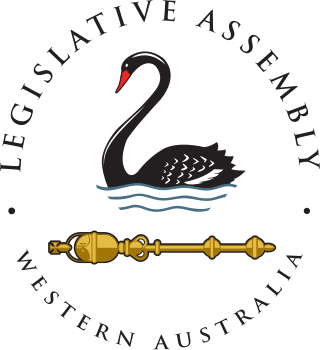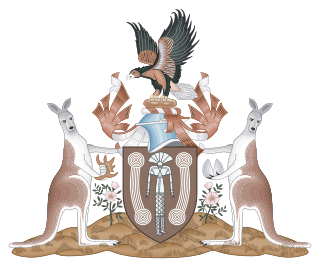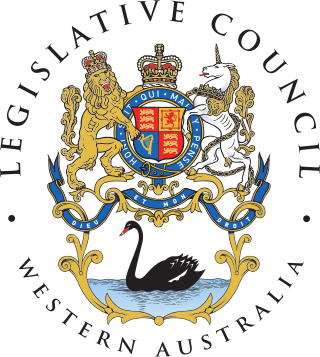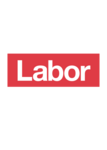Bicameralism is a type of legislature that is divided into two separate assemblies, chambers, or houses, known as a bicameral legislature. Bicameralism is distinguished from unicameralism, in which all members deliberate and vote as a single group. As of 2022, roughly 40% of the world's national legislatures are bicameral, while unicameralism represents 60% nationally and much more at the subnational level.
Electoral systems of the Australian states and territories are broadly similar to the electoral system used in federal elections in Australia.
The premiers and chief ministers of the Australian states and territories are the heads of the executive governments in the six states and two self-governing territories of Australia. They perform the same function at the state and territory level as the Prime Minister of Australia performs at the national level. The King of Australia and the state governors are the formal repositories of executive power; however, in practice they act only on the advice of state premiers and ministers except in extreme circumstances, such as a constitutional crisis.

The New South Wales Legislative Council, often referred to as the upper house, is one of the two chambers of the parliament of the Australian state of New South Wales. The other is the Legislative Assembly. Both sit at Parliament House in the state capital, Sydney. It is normal for legislation to be first deliberated on and passed by the Legislative Assembly before being considered by the Legislative Council, which acts in the main as a house of review.

The Victorian Legislative Council (VLC) is the upper house of the bicameral Parliament of Victoria, Australia, the lower house being the Legislative Assembly. Both houses sit at Parliament House in Spring Street, Melbourne. The Legislative Council serves as a house of review, in a similar fashion to its federal counterpart, the Australian Senate. Although, it is possible for legislation to be first introduced in the Council, most bills receive their first hearing in the Legislative Assembly.

The Western Australian Legislative Assembly, or lower house, is one of the two chambers of the Parliament of Western Australia, an Australian state. The Parliament sits in Parliament House in the Western Australian capital, Perth.

The Legislative Assembly of the Northern Territory is the unicameral legislature of the Northern Territory of Australia. The Legislative Assembly has 25 members, each elected in single-member electorates for four-year terms. The voting method for the Assembly is the full-preferential voting system, having previously been optional preferential voting. Elections are on the fourth Saturday in August of the fourth year after the previous election, but can be earlier in the event of a no confidence vote in the Government. The most recent election for the Legislative Assembly was the 2020 election held on 22 August 2020. The next election is scheduled for 24 August 2024.

Elections in Zambia take place within the framework of a multi-party democracy and a presidential system. The President and National Assembly are simultaneously elected for five-year terms.

The Western Australian Legislative Council is the upper house of the Parliament of Western Australia, a state of Australia. It is regarded as a house of review for legislation passed by the Legislative Assembly, the lower house. The two Houses of Parliament sit in Parliament House in the state capital, Perth.
A member of the Legislative Assembly (MLA) is a representative elected to sit in a legislative assembly. Most often, the term refers the legislature of a federated state or autonomous region, but is also the name of several national legislatures.
The Mining and Pastoral Region is a multi-member electoral region of the Western Australian Legislative Council, located in the northern and eastern regions of the state. It was created by the Acts Amendment Act 1987, and became effective on 22 May 1989 with five members who had been elected at the 1989 state election three months earlier. At the 2008 election, it was increased to six members.

The Northern Territory Legislative Council was the partly elected governing body of the Northern Territory of Australia from 1947 until its replacement by the fully elected Northern Territory Legislative Assembly in 1974.
The Yukon Territorial Council was a political body in the Canadian territory of Yukon, prior to the creation of the Yukon Legislative Assembly. Although not a full legislature, the council acted as an advisory body to the Commissioner of Yukon, and had the power to pass non-binding motions of legislation which would be forwarded to the commissioner for consideration.

The Parliament of the Northern Territory is the unicameral legislature of the Northern Territory of Australia. It consists of the Northern Territory Legislative Assembly and the Administrator of the Northern Territory, who represents the Governor-General. It is one of three unicameral parliaments in Australia, along with those of Queensland and the Australian Capital Territory. The Legislative Assembly replaced the previous Legislative Council in 1974. It sits in Parliament House, Darwin.

The Territory Labor Party, officially known as the Australian Labor Party (Northern Territory Branch) and commonly referred to simply as Territory Labor, is the Northern Territory branch of the Australian Labor Party. It is the current ruling party in the Northern Territory and is led by Natasha Fyles, who has concurrently served as chief minister of the Northern Territory since 2022, and previously Michael Gunner from 2016 to 2022.

This is a list of members of the Northern Territory Legislative Council from 13 December 1947 to 10 December 1949.
This is a list of members of the Northern Territory Legislative Council from 10 December 1949 to 28 April 1951.
This is a list of members of the Northern Territory Legislative Council from 29 May 1954 to 23 January 1957.
This is a list of members of the Northern Territory Legislative Council from 23 January 1957 to 20 February 1960.
This is a list of members of the Northern Territory Legislative Council from 20 February 1960 to 8 December 1962.








